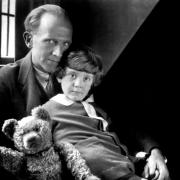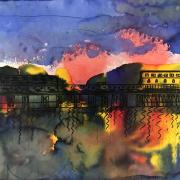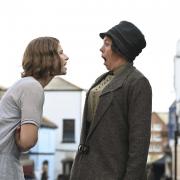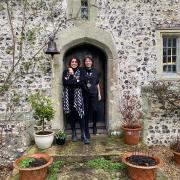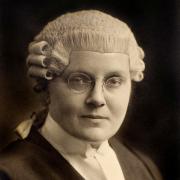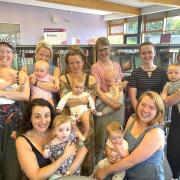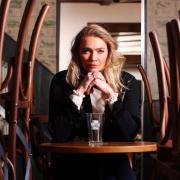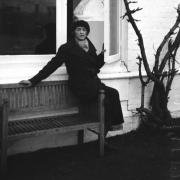Author Kathryn Aalto has loved A. A. Milne’s Winnie-the-Pooh books since early childhood. Here she walks us through the landscape that inspired the stories, where a little boy and his Bear will always be playing.

The Hundred Acre Wood is the setting for two of the most beloved children’s books ever written, Winnie-the-Pooh and The House at Pooh Corner. Written by A. A. Milne and illustrated by E. H. Shepard, they have captured the soul and essence of childhood for millions of people for nearly 90 years.
Time and childhood stand still in the books. Milne’s clever wordplay, silly plot twists and lessons in empathy, friendship and kindness are loved the world over. The Hundred Acre Wood is the warm and nostalgic place where Christopher Robin and his friends Winnie-the-Pooh, Piglet, Rabbit, Tigger, Owl, Eeyore, Kanga and Roo still wander in our minds.
The Hundred Acre Wood is located near Hartfield and Forest Row in East Sussex. It is based on Ashdown Forest, the Five Hundred Acre Wood and Posingford Wood. These three places are practically a stone’s throw away from Cotchford Farm; a country home Mile bought in 1925. Already world-famous as a humorist and playwright, Milne moved here so that his son, the real Christopher Robin, born in 1920, could have the same golden childhood he had in the 1880s wandering the English countryside. His wife, Daphne, could also express her love of gardening here.
While the fictional Hundred Acre Wood is fixed and static in our minds and on paper, Ashdown Forest is a living, breathing landscape. Like your own garden, it has changed since 1926 and 1928 when the books were published: trees – so prevalent in the stories as homes for the characters – have grown and died. Streams have moved and meandered. There have been fires and a hurricane, too, in 1987.
Yet much looks the same as the original Shepard illustrations. Many places in the Hundred Acre Wood are as alive now as they were when Christopher Robin was a child. These include The Enchanted Place, Poohsticks Bridge, Roo’s Sandy Pit, the North Pole and many other places.
Pack a smackerel of something in your rucksack, slip on your wellies. Let’s go there now.

Like many visitors to a new place, you may want to negotiate with a map. The first one to pop to mind may be Shepard’s beautifully hand-drawn Hundred Acre Wood, with treehouses, rivers, and woods. I am often asked if these two places are one and the same. Can Shepard’s map be used as a guide to Ashdown Forest? Though charming, that map is fictional but based on real places in the landscape – some of which we can visit today.
Christopher Robin’s House
The first stories in Winnie-the-Pooh were inspired by places at home where Christopher Robin played. A key feature at the entrance to Cotchford Farm was an old walnut tree with a deep crevice. It stood for more than 200 years and came down in the early 1970s. Either an English or black walnut tree, it was the original tree where the real Christopher Robin played and inspired his father to write stories in which treehouses are so prevalent.
Eeyore’s House

From rabbit burrows in the ground to nests in trees belonging to stone chats, Dartford warblers and firecrests, among many others, animal houses are everywhere in Ashdown Forest. Rangers also turn a blind eye to the occasional Eeyore House that pops up in the woods of Ashdown Forest. It is a small A-frame tent of wooden sticks. In the winter scene of chapter one in The House at Pooh Corner, Pooh and Piglet stop by a little pine wood, feeling sad for Eeyore: he needs a better house than the airy one made of sticks he calls home. They decide to fetch sticks from the other side of the spinney. It turns out Pooh and Piglet have dismantled Eeyore’e real house and have reconstructed it without anyone realising, at first, what has been done.
Galleons Lap
A lifelong lover of the natural world and landscapes, Milne enjoyed walking with Daphne, Christopher Robin and their nanny. They often walked single-file through grasses and gorse, heather and bracken from Cotchford Farm to the tallest spot in the Hundred Acre Wood known as Gills Lap, or Galleons Lap. It is here where many of the stories take place. On paper and in reality, the world here seems entirely open. It is a large sandy plateau with views to Wrens Warren, to the South Downs, and beyond. In winter, the wind is bracing. The sky is big. Solitary Scots pines and tree clumps can be seen for miles.
The Enchanted Place
The Enchanted Place is among the most memorable settings in children’s literature. Both meeting place and metaphor, it is where a boy asks his bear to remember him as he leaves childhood behind.
In the final chapter of The House at Pooh Corner, there is a sense even among the smallest animals of the Enchanted Place that “Things are going to be different.” Christopher Robin is going away. Nobody in the forest knows why. Rabbit decides he must brain out an official response to this hopelessness. He writes a Rissolution, and the forest animals sign it. They tell their friend they love him. In real life, the Enchanted Place is a tree clump on top of Gills Lap.
E. H. Shepard illustrates the Enchanted Place as a beautiful sanctuary of golden light and long, thoughtful shadows. In real life, it is illuminated and wholly enchanting – a place where magical thinking and Doing Nothing is still allowed. From his bedroom, Christopher Robin could just see the trees from his bedroom window. Clusters of trees strike deep chords in us for protection and refuge, just as friendships do for children, their stuffed animals and adults. Stepping inside the cluster of trees, it feels like being in a nest or the arms of our mother. Here, Christopher Robin leaves behind childhood and his beloved forest friends.
Poohsticks Bridge
Never has there been a bridge as iconic and humble as Poohsticks Bridge. A short walk down a dirt lane from Cotchford Farm, the wooden bridge extends across a tributary to the Medway in a quiet shady place in the woods. Between 1925 and 1940, Christopher Robin and his father dropped sticks upriver and watched as they floated under the bridge. For centuries, it was called Posingford Bridge, but as the books gained in popularity and people realised it wasn’t just a fictional place in the Hundred Acre Wood, its name was changed. Bring your own sticks to lessen the damage to surrounding trees.
The North Pole
At the turn of the 20th century, expeditions to the North and South Poles were big headline news. People had fantastical ideas about the kinds of worlds at the poles: lost worlds, Shangri-La, new civilisations. The preparation, climax, and end of these missions would have been the topic at kitchen tables, newsagents and cafés everywhere. It was in this big news of the day that Milne wrote the story, “In Which Christopher Robin Leads an Expotition to the North Pole.” Perhaps Christopher Robin had heard his father talk about the expeditions as he plotted his own. With parents who cultivated his imagination, he could have been acting out a small person’s version of larger adventures and his father wrote a story based on observing his son, often the origin of the stories.
The grown Christopher Robin said the North Pole is not far from Cotchford Farm. “A path from Gills Lap takes you to the main road. On the other side of the Forest falls away to a valley, then rises again beyond to distant trees.” A stream – known as a “ghyll” – meanders through the bottom of this valley. This is the North Pole in the Hundred Acre Wood.
Roo’s Sandy Pit
In Ashdown Forest, there is a real Sandy Pit that inspired the story “In Which Kanga and Baby Roo Come to the Forest.” Here Roo practises being a kangaroo by leaping in the soft sand. A short walk on a white sandy track from the Enchanted Place, it is a low and wide depression, the remnants of a former quarry for stone used in constructing roads in the area. There are many similar depressions in the forest. Today this one is less a sandy pit than a place where wetland plants now grow. Surrounded by Scots pines, in summer, bumblebees alight on purple thistles and leaves rustle in the trees. And if you listen closely, you might still hear Roo laughing as he falls into mouse holes.

Kathryn Aalto is the author of The Natural World of Winnie-the-Pooh: A Walk Through the Forest that Inspired the Hundred Acre Wood (Timber Press).
READ ON
• Peter James: meeting up with Lee Child in New York and how taxis in the Big Apple compare to the ones in Sussex - Bestselling crime writer Peter James talks us through his gastronomic adventures and keeps us abreast of everything relating to his fictional detective, Roy Grace
• Inside a beautifully built Peacehaven home - Jon and Jill Dudley’s Peacehaven house was so beautifully built that it became a show home before it was even completed, and a whole company was born on the strength of it. Alice Cooke spoke to them about how it all came about




